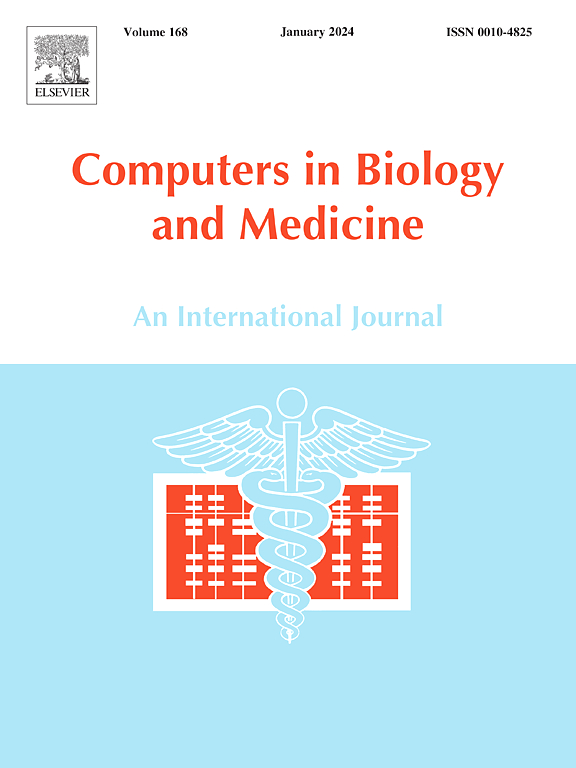基于深度学习形变配准的完整骨盆螺钉通道自动规划
IF 7
2区 医学
Q1 BIOLOGY
引用次数: 0
摘要
骨盆外伤手术中的经皮螺钉固定技术是一项极具挑战性的手术,通常需要在连续的术中x线指导下进行反复试验。利用外科导航系统可以简化这一过程。了解骨盆骨内通道的复杂性对于确定最佳螺钉通道至关重要,这有助于术前规划和术中应用。传统的螺钉通道搜索算法需要遍历螺钉的入口和出口区域,计算通道轴到骨面的距离来确定螺钉的位置。这个过程在计算上是复杂的,并且由医生手工测量是耗时的,劳动密集型的,并且依赖于经验。在本研究中,我们提出了一种基于深度学习可变形配准技术的骨盆螺钉通道自动规划算法,该算法可以高效准确地识别最佳螺钉通道。与传统方法相比,本研究的创新之处在于:(1)在螺杆定位中引入了通道安全范围约束,提高了搜索效率;(2)应用深度学习变形配准,方便自动标注螺钉出入口区域,以及走廊安全范围;(3)开发了一种高效的最优走廊搜索算法,在不遍历出入口区域的情况下快速确定走廊,并通过基于矢量的直径计算方法提高了效率。整个算法框架由三个关键部分组成:图集生成模块、可变形配准模块和最优廊道搜索策略。在实验中,我们测试了该算法在198个完整骨盆上的性能,用于计算最佳前柱通道和S1骶髂螺钉。结果表明,与人工测量相比,新算法可将通道直径增加2.1% ~ 3.3%,同时将前柱通道和骶髂S1通道的平均时间分别从1038s和3398s显著降低到18.9s和26.7s。这证明了该算法在效率和准确性方面的优势。然而,目前的方法仅在完整的骨盆上得到验证;骨盆骨折的情况需要进一步的研究。本文章由计算机程序翻译,如有差异,请以英文原文为准。
The automatic pelvic screw corridor planning for intact pelvises based on deep learning deformable registration
Percutaneous screw fixation technique in pelvic trauma surgery is an extremely challenging operation that typically requires a trial-and-error insertion process under the guidance of continuous intraoperative X-ray. This process can be simplified by utilizing surgical navigation systems. Understanding the complexity of the intraosseous pelvis corridor is essential for establishing the optimal screw corridor, which further facilitates preoperative planning and intraoperative application. Traditional screw corridor search algorithms necessitate traversing the entrance and exit areas of the screw and calculating the distance from the corridor axis to the bone surface to ascertain the location of the screw. This process is computationally complex, and manual measurement by the physician is time consuming, labor intensive, and empirically dependent. In this study, we propose an automated planning algorithm for pelvic screw corridors based on deep learning deformable registration technology, which can efficiently and accurately identify the optimal screw corridors. Compared to traditional methods, the innovations of this study include: (1) the introduction of corridor safety range constraints on screw positioning, which enhances search efficiency; (2) the application of deep learning deformable registration to facilitate the automatic annotation of the screw entrance and exit areas, as well as the safety range of the corridor; and (3) the development of a highly efficient algorithm for optimal corridor searching, quickly determining the corridor without traversing the entrance and exit areas and enhancing efficiency via a vector-based diameter calculation method. The whole framework of the algorithm consists of three key components: atlas generation module, deformable registration and optimal corridor searching strategy. In the experiments, we test the performance of the proposed algorithm on 198 intact pelvises for calculating the optimal corridor of anterior column corridor and S1 sacroiliac screws. The results show that the new algorithm can increase the corridor diameter by 2.1%–3.3% compared to manual measurements, while significantly reducing the average time from 1038s and 3398s to 18.9s and 26.7s on anterior column corridor and S1 sacroiliac corridor, respectively, compared to the traditional screw searching algorithm. This demonstrates the advantages of the algorithm in terms of efficiency and accuracy. However, the current method is validated only on intact pelvises; further research is required for pelvic fracture scenarios.
求助全文
通过发布文献求助,成功后即可免费获取论文全文。
去求助
来源期刊

Computers in biology and medicine
工程技术-工程:生物医学
CiteScore
11.70
自引率
10.40%
发文量
1086
审稿时长
74 days
期刊介绍:
Computers in Biology and Medicine is an international forum for sharing groundbreaking advancements in the use of computers in bioscience and medicine. This journal serves as a medium for communicating essential research, instruction, ideas, and information regarding the rapidly evolving field of computer applications in these domains. By encouraging the exchange of knowledge, we aim to facilitate progress and innovation in the utilization of computers in biology and medicine.
 求助内容:
求助内容: 应助结果提醒方式:
应助结果提醒方式:


